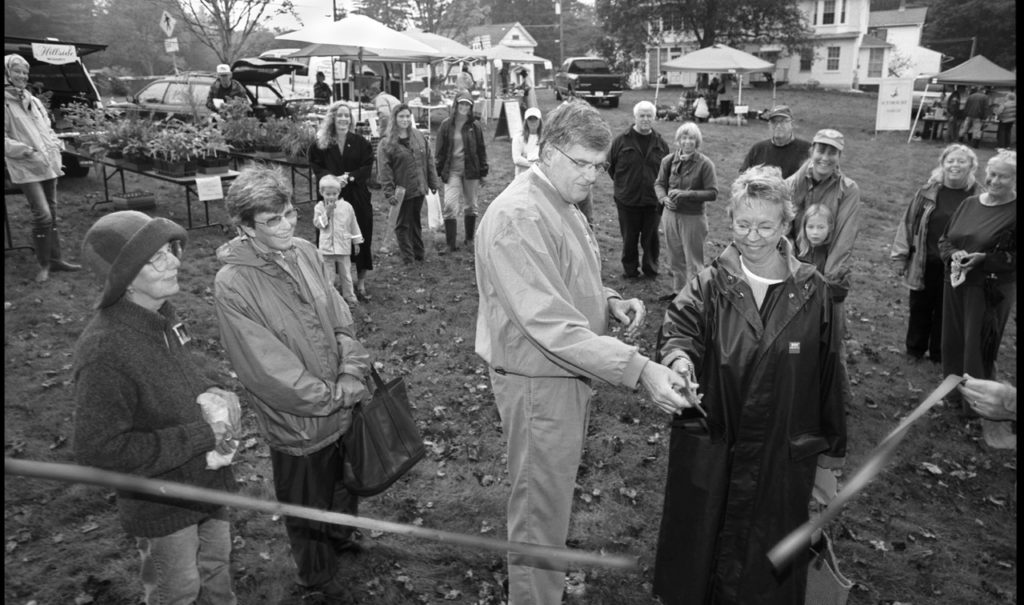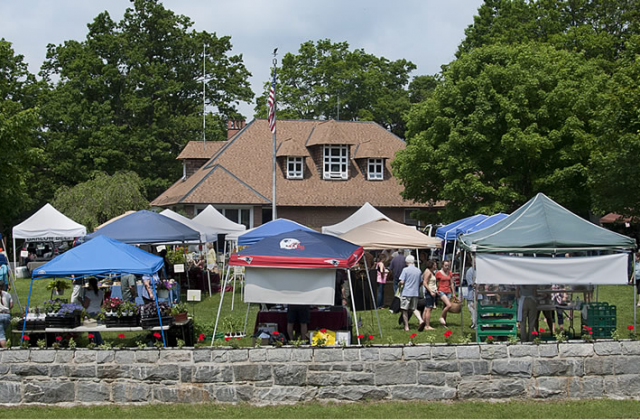Norfolk Farmers Market
A Proud History and a Bright Future
By Jude Mead
Photo by Bruce Frisch
When the farmers market began to make a slow comeback about 13 years ago on the West Coast and in urban areas, Norfolk’s Economic Development Commission took notice of the trend. They also paid attention to the clean food movement and saw an opportunity to provide a healthy alternative to overcrowded supermarkets. A short time later they launched the first Norfolk Farmers Market on an empty lot at the edge of town where the Norfolk ambulance building now resides.
Lisa Auclair, manager of the market during that time, said there were no working farms in Norfolk then but that she had the support of some strong farms from surrounding towns, a few local family gardeners and several artisans who brought their produce and goods to the market. “Though we started off small, we did have some strong anchor vendors. We ran five markets in the first year, moved to biweekly the next year and weekly by the third year. We had a good location on Route 44, so lots of traffic,” said Auclair.

Today the market is still viable and has moved to the lawn of the Norfolk Town Hall. It runs year round with a winter market held inside. In just a few weeks the outside market will resume once again. Auclair, who now serves as board chairperson, says its success is partially due to its having kept the farmer at the center of the market. “We continue to have artisans but our responsibility is to the farmer and to local agriculture. We want to provide high quality fresh produce to the consumer,” said Auclair.
Times have changed and so has the market. It offers more vendors and artisans as well as entertainment, crafts, and special events. “We have become a destination market. People come to see all our special programs,” said Auclair. Some of the programs that have been integrated into the market include Cook the Market, where they have cooking demonstrations using food from the market with free tasting samples; a special day dedicated to dogs; and a Children’s Day with plenty of games to play.
What Auclair is most proud of,though,is being able educate the consumer. “I want to educate people about food, where it comes from, how to prepare it, and how it is grown,” she said. She is also excited about a new program the board initiated using “market bucks,” which are given away to area churches for food assistance. These market bucks are treated like gift certificates but can be used only on food products. “We are able to do this because of the generous donations we receive from the community. We are also helping more people become aware of healthy eating,” said Auclair. She added that most market bucks are given and can be redeemed from the town hall.
What is the future of the farmers[ market? That depends on the farmers and consumers. There has been an explosion of farmers markets in the last several years. According to Jamie Smith, spokesperson and market expert with the Department of Agriculture, only a handful of markets existed in Connecticut back in 2006 when Norfolk set up its tents. “Today we have well over 125 in Connecticut, and nationwide there are well over 8,000,” said Smith.
The increase in number and popularity of farmers markets over the years, however, has dispersed the consumer,and the volume of foot traffic has decreased at most markets. Smith said the way people buy locally has changed. “Many people are buying through Community Supported Agriculture (CSA), or smaller grocery stores that carry local foods. Even the larger grocery stores have local products and a bigger selection of fresh produce today,” said Smith.
She added that food hubs are also popping up in the state and offer one stop shopping for locally sourced items. Smith said the hubs are convenient for both the farmer and the busy consumer. “The farmer sells directly to the hub. The hub sells to institutional buyers such as restaurants, schools, hospitals, etc. as well as to the individual consumer,” she said. In other words,the hub is the connection for farmers to gain access to larger markets with a lot less physical effort than going to several farmers markets per week.
Also coming down the road in the future are some policy changes in food safety. The state wants to provide more food safety education and be more proactive in ensuring safe food at the market. “We check for a variety of things such as making sure that meats and other perishables are kept at the proper temperature. In order to do this we periodically send out inspectors,” said Smith.
Another change is the updated Food Safety Modernization Act. Smith explained that the goal of the FSMA is to focus food safety on prevention, with new rules and regulations on the production and handling of foods. “Produce farmers and food manufacturers of all types and sizes need to know if and how the rules apply to them,” said Smith.
Auclair understands that markets change, new policies are introduced and people’s needs shift. One thing that won’t change, she said, is that farmers markets are an important source of local and fresh food and people are not about to give that up. “We are always learning and bringing in new ideas. I want to see more food education and add more interesting events. We will most likely remain a destination market, where people will continue to come from throughout the area to shop here,” said Auclair.
Be sure to visit the Norfolk Farmers Market on opening day. You will find fresh local produce, friendly farmers, and creative artisans. The market will open May 18 from 10 a.m. to 1 p.m.

